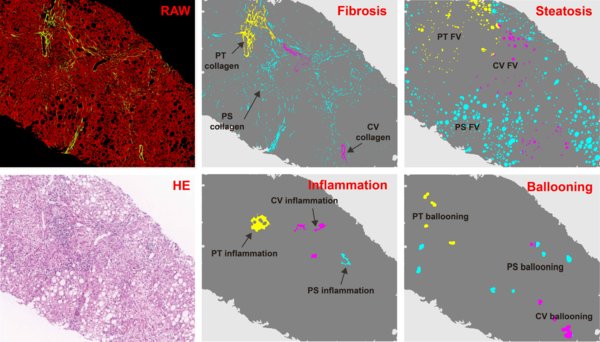qFIBS Demonstrates Suitability for Nonalcoholic Steatohepatitis (NASH) Assessment in Clinical Trials and Patient Care with Full Quantification of All Crucial Histopathological Features
SINGAPORE,Nov. 11,2019 --qFIBS,a novel automated algorithm developed by HistoIndex,has been shown to accurately distinguish different grades and stages of histological NASH features with a continuous measurement approach. This was highlighted in an international,multicenter collaborative study conducted by pathologists and hepatologists from China,Singapore,Europe and United States.
This study,published recently in Hepatology* - a top-ranked peer-reviewed journal,was initiated to validate qFIBS for the evaluation of four crucial NASH features – fibrosis,lobular inflammation,hepatocyte ballooning,and steatosis – with the goal of showing a continuous quantitative,automated and accurate assessment of disease severity. Using 219 adult non-alcoholic fatty liver disease (NAFLD)/NASH liver biopsy samples from this global collaboration provided opportunities for the study to demonstrate the potential of qFIBS in assessing all key histopathological characteristics of NASH,as well as utility across differing ethnicities,environmental/nutritional backgrounds,age groups and disease severity. Findings from this study show that qFIBS assessments are more useful than current semiquantitative scores to measure NASH activity and quantify patients' responses to therapeutics used in clinical trials or patient care.
NASH is liver inflammation and damage caused by lipotoxic fat,and is a potentially progressive liver disease that can lead to cirrhosis,hepatocellular carcinoma,liver transplantation,and death. The global prevalence of NAFLD is increasing in line with obesity,and China is one of the countries facing a major health crisis,having seen a dramatic increase in their population affected by NAFLD from 18% to 29% within a decade1,2; this prevalence has increased more than twice the rate in Western countries. China is expected to hit the highest growth globally in the prevalence of NAFLD,with about 315 million cases by 20303.
Says Prof Wei Lai,corresponding author of this study and renowned hepatologist from the Peking University Hepatology Institute at the Peking University People's Hospital,"As China expects a spike in the prevalence of NAFLD,there is also a concerning situation of these cases progressing to NASH. This has prompted multiple drug discovery studies and clinical trials in China looking into NASH. And,inadequate diagnosis and follow-up are also due to the lack of reliable and cost-effective diagnostic tools for NAFLD,especially for NASH4. Having a precise digital pathology tool with AI-based imaging and analytical capabilities will help us derive a clearer assessment of liver biopsies,as well as provide significant histopathological insights in NASH clinical trials,ultimately leading to treatments that benefit NASH patients."
AI-based Digital Pathology Imaging System
HistoIndex's digital pathology platform,which is based on Second Harmonic Generation (SHG) and Two-photon Excitation Fluorescence (TPEF) imaging technology to producehigh-resolution images of liver biopsies,which are unstained to further eliminate the potential variation caused by staining. qFIBS is then employed to automatically recognize the key features of NASH in various regions of the Central Vein (CV),Portal Tract (PT),and Perisinusoidal (PS) within the biopsies (as seen in Image A),before generating a fully quantified and consistent analysis of the images to determine the severity and monitor the changes in fibrosis,lobular inflammation,hepatocyte ballooning and steatosis that are minute yet important.

qFIBS is employed to automatically recognize the key features of NASH in various regions of the Central Vein (CV),and Perisinusoidal (PS) within the liver biopsies,hepatocyte ballooning and steatosis,which are minute yet important. Picture Credits: © HistoIndex
qFIBS is quantified in a continuous-scale to provide the most precise measurement of the relevant NASH features. This is in contrast to the existing conventional discrete staging and scoring methods,which are semiquantitative and may incur potential inter- and intra-observer variability. It is therefore essential for hepatologists and pathologists to be equipped with qFIBS; a robust,standardized and fully quantitativeadjunct tool to facilitate reproducible and precise liver biopsy assessments,in order to monitor changes in the liver tissue that are clinically relevant due to therapeutic intervention in NASH clinical trials.
Says Dr Stephen Harrison,Medical Director of Pinnacle Clinical Research and President of Summit Clinical Research,and co-author of the multicenter study,"In clinical trials today,we depend on the ability to measure critical NASH liver biopsy characteristics especially in determining the extent of fibrosis and steatosis at the various regions of the biopsy,which is very important in assessing post-treatment responses. To assist pathologists in their assessments,it is imperative for pharmaceutical and biotech companies to consider working with a fully quantifiable tool such as qFIBS to provide accurate,standardized and consistent data in clinical trials."
Sharing in cohesion with this statement is fellow co-author,A/Prof. Jason Chang,Head and Senior Consultant,Department of Gastroenterology & Hepatology,Singapore General Hospital (SGH),"qFIBS plays a pivotal role in this global multicenter study for the development of biomarkers,so as to efficiently diagnose,risk stratify and monitor NAFLD/NASH progression and treatment. qFIBS can potentially work well concomitantly with these biomarkers in clinical trials as a drug development tool as well as for patient care in the near future."
*Note to Editors:
The international,multicenter collaborative study mentioned in this press release,qFIBS: A Novel Automated Technique for Quantitative Evaluation of Fibrosis,Inflammation,Ballooning,and Steatosis in Patients With Nonalcoholic Steatohepatitis,was published in the HEPATOLOGY journal on 10 October 2019. https://doi.org/10.1002/hep.30986. The premier publication in the field of liver disease,HEPATOLOGY publishes original,peer-reviewed articles concerning all aspects of liver structure,function and disease.
References:
1) New trends on obesity and NAFLD in Asia. J Hepatol 2017;67:862-873.
2) Global epidemiology of nonalcoholic fatty liver disease — meta-analytic assessment of prevalence,incidence,and outcomes. Hepatology 2016;64:73-84.
3) Modeling NAFLD disease burden in China,France,Germany,Italy,Japan,Spain,United Kingdom,and United States for the period 2016–2030. J Hepatol 2018;69:896-904.
4) Unexpected Rapid Increase in the Burden of NAFLD in China From 2008 to 2018: A Systematic Review and Meta-Analysis. Hepatology 2019,Vol . 70,No. 4.
Photo - /20191111/2638151-1?lang=0